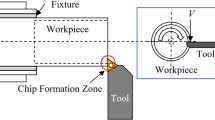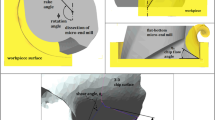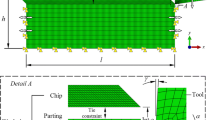Abstract
In this work, the machining of ultra-fine-grained pure titanium (UFG Ti) in an integrated manufacturing process combining severe plastic deformation (SPD) process and machining process is investigated through analytical modeling with experimental validation. UFG Ti is increasing finding usefulness in lightweight engineering applications and biomedical applications because of its sufficient mechanical strength, manufacturability, and biocompatibility. The UFG Ti is prepared by a SPD process, namely equal channel angular extrusion (ECAE) from commercial pure grade 4 titanium. However, the machining process in the integrated manufacturing process has not been fully understood in the context of machining forces and temperatures. The machining forces are predicted in this work using extended chip formation model. In this model, the average temperature at the primary shear zone is calculated based on the equilibrium between generated heat and plastic work. Orthogonal cutting tests were conducted under various cutting conditions with experimental force measurements using a piezoelectric dynamometer. Good agreements are observed between predicted forces and experimental forces. In addition, sensitivity analyses were performed to investigate the influence of input J-C constants and cutting condition parameters on the accuracy of the predicted machining forces. The predicted machining forces were compared to machining forces of Ti-6Al-4V alloy under various cutting conditions, which are widely used in engineering and biomedical applications. This work extends the applicability of analytical models in machining to a broader class of materials. It will promote the use of UFG Ti and the integrated manufacturing process in engineering and biomedical applications.
Similar content being viewed by others
References
Elias CN, Meyers MA, Valiev RZ, Monteiro SN (2013) Ultra fine grained titanium for biomedical applications: an overview of performance. J Materials Res Technol 2(4):340–350. https://doi.org/10.1016/j.jmrt.2013.07.003
Latysh V, Krallics G, Alexandrov I, Fodor A (2006) Application of bulk nanostructured materials in medicine. Curr Appl Phys 6(2):262–266. https://doi.org/10.1016/j.cap.2005.07.053
Stolyarov VV, Zhu YT, Alexandrov IV, Lowe TC, Valiev RZ (2001) Influence of ECAP routes on the microstructure and properties of pure Ti. Mater Sci Eng A 299(1–2):59–67
Morehead, M. D., & Zhu, Y. T. (2000). Experimental investigation of the machinability of equal channel angular pressing processed commercially pure titanium. Society of Manufacturing Engineers, DOI: https://doi.org/10.1001/archinte.160.13.1926
Lapovok R, Molotnikov A, Levin Y, Bandaranayake A, Estrin Y (2012) Machining of coarse grained and ultra fine grained titanium. J Mater Sci 47(11):4589–4594. https://doi.org/10.1007/s10853-012-6320-7
Stolyarov VV, Zhu YT, Lowe TC, Valiev RZ (2001) Microstructure and properties of pure Ti processed by ECAP and cold extrusion. Mater Sci Eng A 303(1–2):82–89
Horita Z, Fujinami T, Langdon TG (2001) The potential for scaling ECAP: effect of sample size on grain refinement and mechanical properties. Mater Sci Eng A 318(1–2):34–41
Stolyarov VV, Zhu YT, Alexandrov IV, Lowe TC, Valiev RZ (2001) Influence of ECAP routes on the microstructure and properties of pure Ti. Mater Sci Eng A 299(1–2):59–67
Stolyarov VV, Zhu YT, Alexandrov IV, Lowe TC, Valiev RZ (2003) Grain refinement and properties of pure Ti processed by warm ECAP and cold rolling. Mater Sci Eng A 343(1–2):43–50
Ivester RW, Kennedy M, Davies M, Stevenson R, Thiele J, Furness R, Athavale S (2000) Assessment of machining models: progress report. Mach Sci Technol 4(3):511–538. https://doi.org/10.1080/10940340008945720
Karpat Y, Özel T (2006) Predictive analytical and thermal modeling of orthogonal cutting process—part I: predictions of tool forces, stresses, and temperature distributions. J Manuf Sci Eng 128(2):435–444. https://doi.org/10.1115/1.2162590
Karpat Y, Özel T (2006) Predictive analytical and thermal modeling of orthogonal cutting process—part II: effect of tool flank wear on tool forces, stresses, and temperature distributions. J Manuf Sci Eng 128(2):445–453. https://doi.org/10.1115/1.2162591
Umbrello D, M’saoubi R, Outeiro JC (2007) The influence of Johnson–Cook material constants on finite element simulation of machining of AISI 316L steel. Int J Mach Tools Manuf 47(3–4):462–470
Gonzalo O, Jauregi H, Uriarte LG, de Lacalle LL (2009) Prediction of specific force coefficients from a FEM cutting model. Int J Adv Manuf Technol 43(3–4):348
Özel T, Llanos I, Soriano J, Arrazola PJ (2011) 3D finite element modelling of chip formation process for machining Inconel 718: comparison of FE software predictions. Mach Sci Technol 15(1):21–46. https://doi.org/10.1080/10910344.2011.557950
Özel T, Ulutan D (2012) Prediction of machining induced residual stresses in turning of titanium and nickel based alloys with experiments and finite element simulations. CIRP Annals-Manufacturing Technol 61(1):547–550. https://doi.org/10.1016/j.cirp.2012.03.100
Danish M, Ginta TL, Habib K, Carou D, Rani AMA, Saha BB (2017) Thermal analysis during turning of AZ31 magnesium alloy under dry and cryogenic conditions. Int J Adv Manuf Technol 91(5–8):2855–2868
Oxley PLB (1989) The mechanics of machining: an analytical approach to assessing machinability. Ellis Horwood Ltd., England, DOI: https://doi.org/10.1016/0008-6215(89)85094-3
Lalwani DI, Mehta NK, Jain PK (2009) Extension of Oxley’s predictive machining theory for Johnson and Cook flow stress model. J Mater Process Technol 209(12–13):5305–5312
Ning J, Liang SY (2018) Prediction of temperature distribution in orthogonal machining based on the mechanics of the cutting process using a constitutive model. J Manufacturing Material Processing 2(2):37. https://doi.org/10.3390/jmmp2020037
Kolsky, H. (1949). An investigation of the mechanical properties of materials at very high rates of loading. Proceedings of the physical society. Section B, 62(11), 676
Jaspers SPFC, Dautzenberg JH (2002) Material behaviour in conditions similar to metal cutting: flow stress in the primary shear zone. J Mater Process Technol 122(2–3):322–330
Khan AS, Suh YS, Kazmi R (2004) Quasi-static and dynamic loading responses and constitutive modeling of titanium alloys. Int J Plast 20(12):2233–2248. https://doi.org/10.1016/j.ijplas.2003.06.005
Shrot A, Bäker M (2012) Determination of Johnson–Cook parameters from machining simulations. Comput Mater Sci 52(1):298–304. https://doi.org/10.1016/j.commatsci.2011.07.035
Agmell M, Ahadi A, Ståhl JE (2014) Identification of plasticity constants from orthogonal cutting and inverse analysis. Mech Mater 77:43–51. https://doi.org/10.1016/j.mechmat.2014.07.005
Tounsi N, Vincenti J, Otho A, Elbestawi MA (2002) From the basic mechanics of orthogonal metal cutting toward the identification of the constitutive equation. Int J Mach Tools Manuf 42(12):1373–1383. https://doi.org/10.1016/S0890-6955(02)00046-9
Ning J, Liang SY (2018) Model-driven determination of Johnson-Cook material constants using temperature and force measurements. Int J Adv Manuf Technol 97(1–4):1053–1060
Ning, J., Nguyen, V., Huang, Y., Hartwig, K. T., & Liang, S. Y. (2018). Inverse determination of Johnson–Cook model constants of ultra-fine-grained titanium based on chip formation model and iterative gradient search. The international journal of advanced manufacturing technology, 1-10, DOI: https://doi.org/10.1016/j.gene.2018.10.036
Oxley, P.L.B., Welsh, M.J.M., 1963. Calculating the shear angle in orthogonal metal cutting from fundamental stress, strain, strain-rate properties of the workpiece material. In: proceedings of the fourth international conference on machine tool design and research conference, pp. 73–86
Adibi-Sedeh AH, Madhavan V, Bahr B (2003) Extension of Oxley’s analysis of machining to use different material models. J Manuf Sci Eng 125(4):656–666. https://doi.org/10.1115/1.1617287
Industrial Administration and Engineering Production Group Applied Mechanics Group, Boothroyd G (1963) Temperatures in orthogonal metal cutting. Proc Inst Mech Eng 177(1):789–810
Aydın M (2016) Cutting temperature analysis considering the improved Oxley’s predictive machining theory. J Braz Soc Mech Sci Eng 38(8):2435–2448. https://doi.org/10.1007/s40430-016-0514-x
Seo S, Min O, Yang H (2005) Constitutive equation for Ti–6Al–4V at high temperatures measured using the SHPB technique. Int J Impact Engineering 31(6):735–754. https://doi.org/10.1016/j.ijimpeng.2004.04.010
Boivineau M, Cagran C, Doytier D, Eyraud V, Nadal MH, Wilthan B, Pottlacher G (2006) Thermophysical properties of solid and liquid Ti-6Al-4V (TA6V) alloy. Int J Thermophys 27(2):507–529. https://doi.org/10.1007/PL00021868
Author information
Authors and Affiliations
Corresponding authors
Rights and permissions
About this article
Cite this article
Ning, J., Nguyen, V. & Liang, S.Y. Analytical modeling of machining forces of ultra-fine-grained titanium. Int J Adv Manuf Technol 101, 627–636 (2019). https://doi.org/10.1007/s00170-018-2889-6
Received:
Accepted:
Published:
Issue Date:
DOI: https://doi.org/10.1007/s00170-018-2889-6




